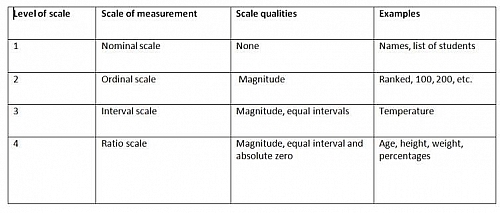
Measurement in statistics may be carried out on at least four levels that relates very closely to the types of empirical concepts identified. The types of numeral assigned to an object or variables determines the type of measurement.
Table of Contents
Four scales of measurements
- Nominal scale
- Ordinal scale or ranking scale
- Interval scale
- Ratio scale
- Nominal Scale: nominal scale is the simplest form of measurement that involves numbers assigned to names, in order words, nominal scale consists of a set of categories that differentiate names. Measurement on a nominal scale labels and categorises observation but do not make any quantitative distinction between or among any observation. For example, when measuring the height of a research object under study, numerical scale considers whether the objects are tall, short or normal without necessarily making use of the numbers. Another example is the list of students in alphabetical order.
- Ordinal or Ranking Scale: ordinal scale of measurement involves ranking of objects from the highest to the lowest in their order of importance. In order words, ordinal scale categorizes objects under consideration by not only having different names (as in nominal scale), but also organised it in a fixed order corresponding to differences of magnitude. Ordinal scale of measurement does not give information on the magnitude of the differences of the element ranks, all that is known is that for examples object A ranked first is greater than object B ranked 2nd, or that the object ranked 6th is higher than object 1 ranked 10th, however, we cannot tell to what degree.
- Interval Scale: this level of measurement allows us to specify how far the interval are far from each other. In addition to convey the idea of magnitude, thus giving a unit of measurement. In Interval scale of measurement, it is possible to say that the difference between two scores is 10 units. It must be remembered that interval scale of measurement has an arbitrary origin for example as in the case of temperature measurement, temperature measured whether on a centigrade or Fahrenheit, it doesnt have a natural origin in zero (0). The values of zeros are in degree centigrade or zero degree. Fahrenheit are only arbitrarily fixed as temperatures in some regions of the world do drop between 00C to let say -100C or to -240C and so on.
- Ratio Scale: the ratio scale is the highest level of measurement, in this scale of measurement, every item has a natural origin in zero. In addition to possessing absolute magnitude with this scale, it is possible to know the intervals and also the actual value on the scale. For example, if you are 20 years old, you not only know that you are five years older someone who is 15 years(magnitude), but you also know that you are five years older (equal intervals) and when a person is born his/hers age is zero. Another example is, we can say with all amount of certainty that the distance between A and B is twice the distance between C and D or that the weight of object A is twice that of object B. This attribute of ratio scale makes it possible for all mathematical operation such as addition, subtraction, multiplication and division and the order to be perform such items.
Empirical Concept of Measurement
Scientists used empirical concept to describe objects and event under study in the real world; in this case, any scientific or geographical problem can be stated in terms of the relationship with empirical concept. Generally, this concepts are considered under the following:
- Classification concepts- these are the simplest form of concepts because they involve little more than identifying object in terms of class.
- Order concepts– these are found in research problems which involves hierarchy of levels for example, in the class of degree awarded in the university, you could have 1st class, 2nd class upper, 2nd lower, 3rd class and pass degree.
- Variable concepts– these consider true observation of some variation of variability in data under consideration. These are concepts in which variables quantities can be assigned.
In the concept of measurement, there are systems of rules that distinguishes one or more of the relationship between or amongst objects. For example, if one is considering a relationship between A and B in respect to some properties of X, there will be four set of rules as follows:
- A (X)= B (X) directional
- A (X)B (X) non-directional, it is not the same as B (X)
- A (X) > B (X) this shows direction of relationship
- A (X) < B (X) this shows directional relation